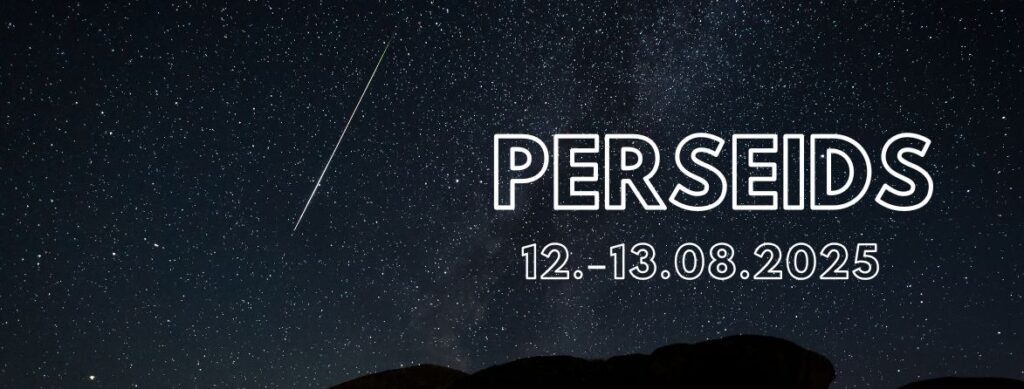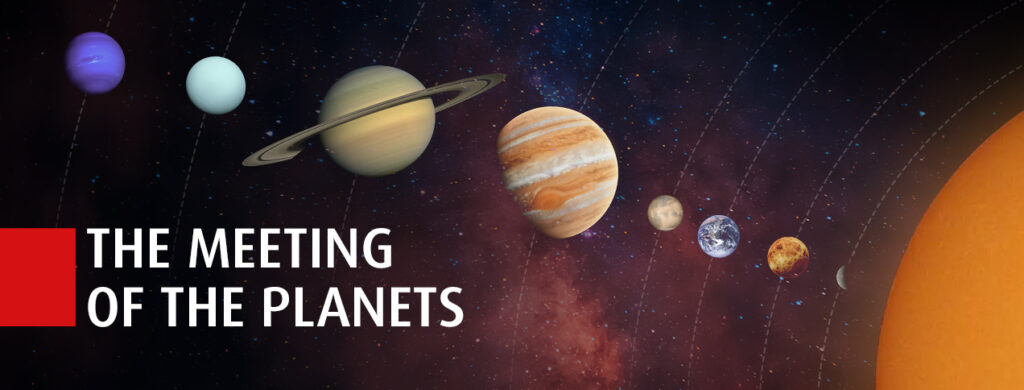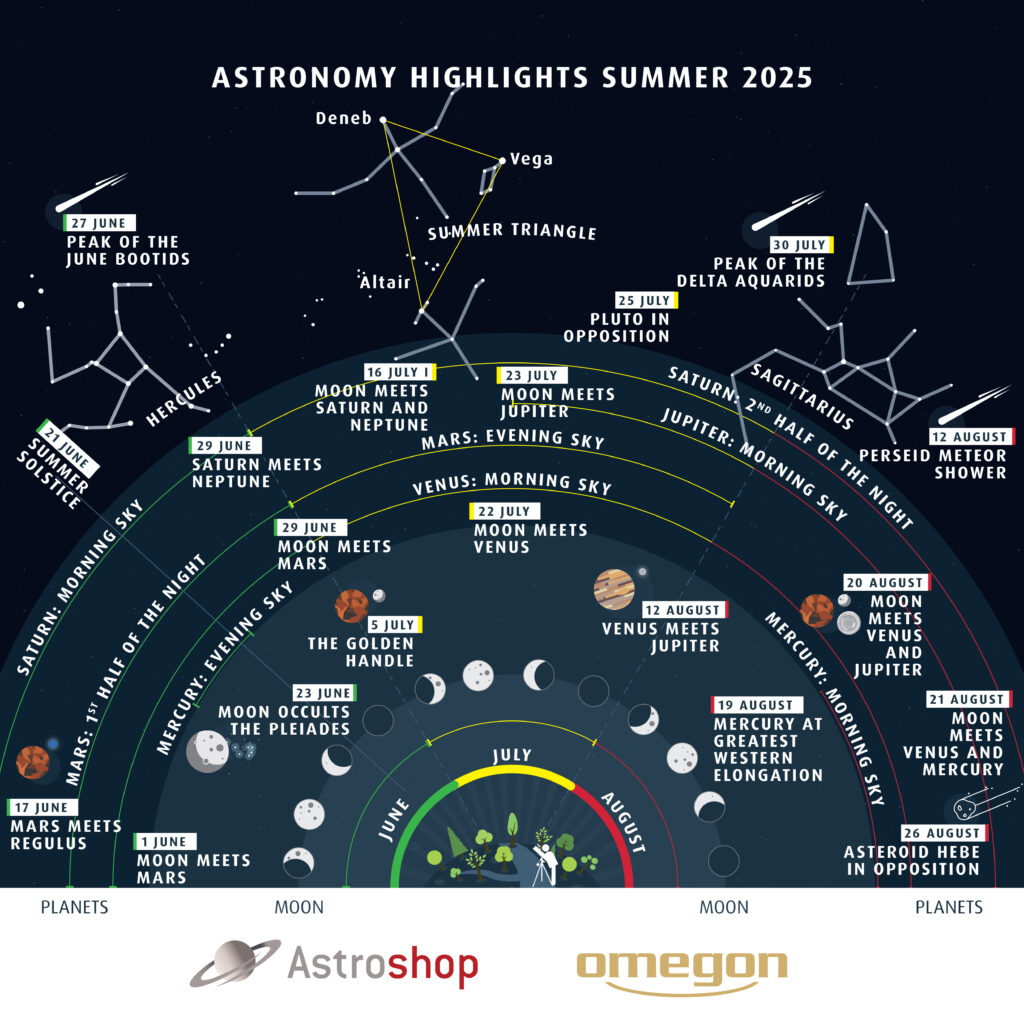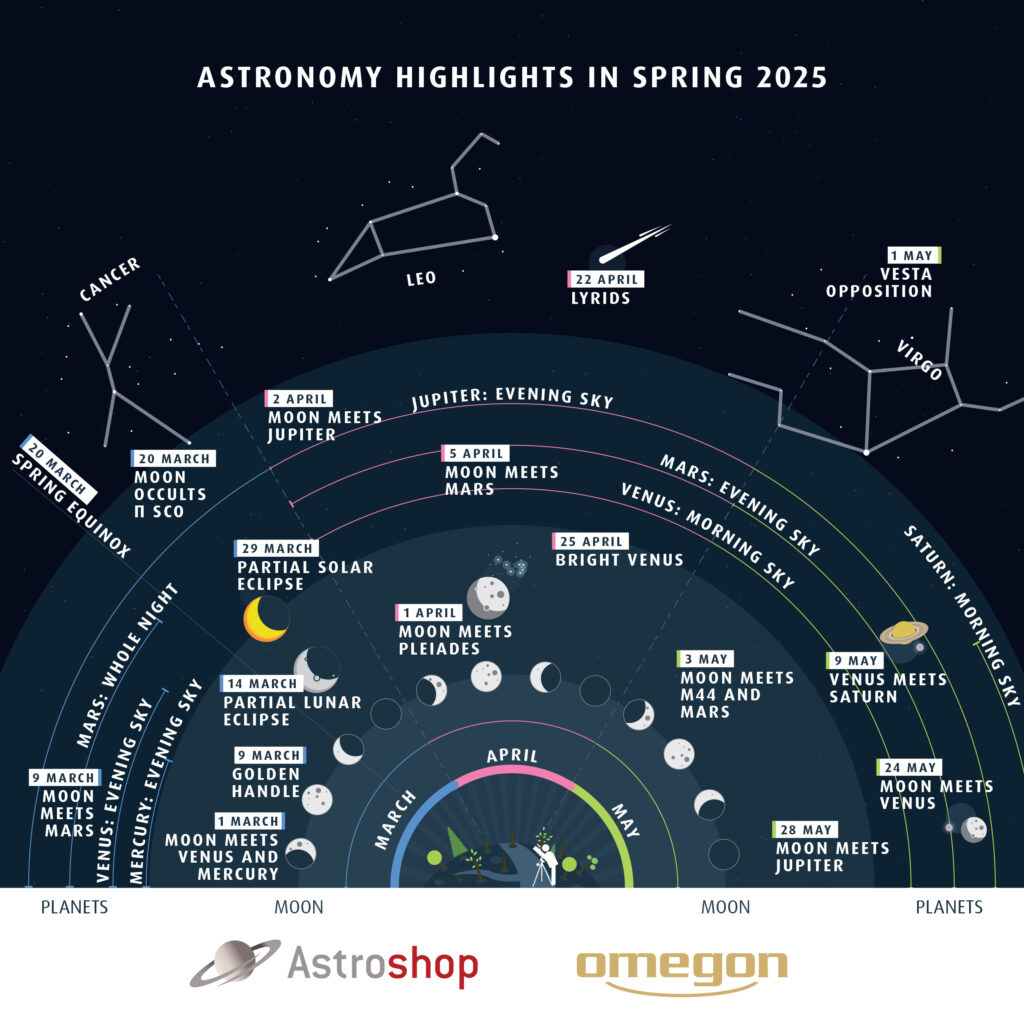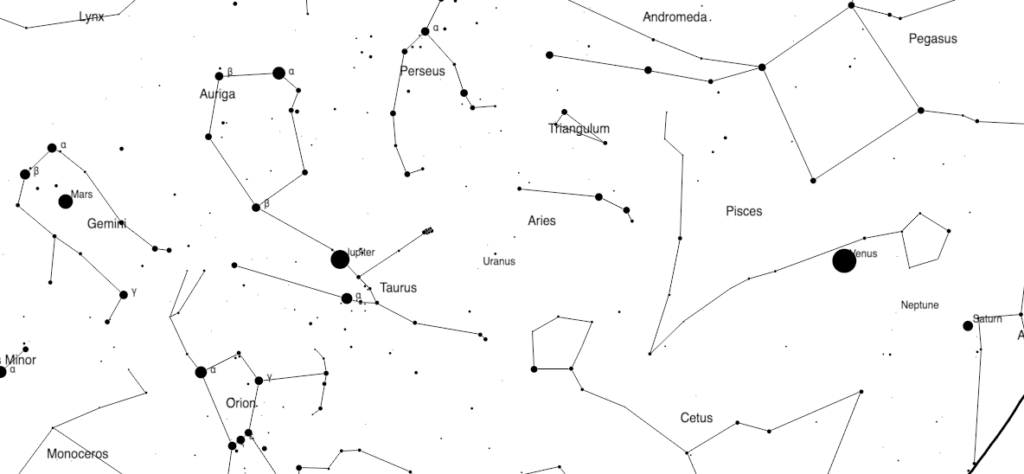The winter draws near and with it the darkest time of the year. Already in the early evening the Winter Hexagon sparkles in the sky and invites you to observe. In the coming three months there is much to discover in the heavens: from the Geminids without disturbing moon‑light to the bright Jupiter and even a small planetary parade in February. Our new astro‑highlights guide you through this time: month by month, star by star.
If you like, you are welcome to embed the graphic on your own website. Please link it then to www.astroshop.eu
December
4 Dec. Moon meets the Pleiades
In the early morning hours the nearly full Moon passes through the constellation Taurus and encounters the Pleiades, one of the most beautiful open star clusters of the winter sky. In binoculars the close encounter appears particularly impressive. Even with the bare eye you recognize the group as a small, sparkling star‑nest next to the Moon. Around 4 a.m. the constellation stands high in the sky and offers a mood‑filled start to the winter observations.
7 Dec. Mercury at greatest western elongation
Shortly before sunrise the otherwise shy Mercury shows itself. At the beginning of December it reaches its greatest western elongation, i.e., the largest separation from the Sun, and thus stands particularly favorably in the morning sky. From about 6:30 a.m. you spot it deep above the south‑eastern horizon, as a small, bright point in the first light of dawn. A clear horizon view is essential, because the time window is short before the Sun outshines it. For early risers the view pays off: Mercury appears as distinctly as hardly any other time of the year.
14 Dec. Maximum of the Geminids
On the night from 13 to 14 December you have, with a bit of weather luck, the chance to admire the most famous winter meteors. This active meteor stream reaches its maximum, and the conditions this year are almost perfect: the Moon hardly disturbs, the sky remains deep dark for most of the time. From midnight the radiant rises high in the sky, and the activity increases once again. Under good conditions you could theoretically count up to 80 meteors per hour. In practice there will be fewer, yet every bright meteor is a moment, right?
21 Dec. Start of winter
Here it is: Winter begins, and at 16:00 the Sun descends as deeply as it never does all year. The day bids farewell early and the night stretches across the remaining hours. For many stargazers this is the finest time of the year: Long nights invite you to set up the telescope after work. From now on the light also returns slowly – barely noticeable, yet a little more each day.
22 Dec. Ursids
Hardly are the Geminids over, the next meteor stream is already on deck. On the night from 22 to 23 December the Ursids reach their maximum. This is a small but fine meteor stream, appearing to come from the constellation Ursa Minor. With about ten meteors per hour it offers no spectacle, but rather a modest finale. In this year no moonlight disturbs, and in the long winter nights you can take your time.
31 Dec. Moon meets the Pleiades
Late in the afternoon dusk sets in, and you discover the bright Moon exactly above the eastern horizon. If the sky is clear, the two bright stars Aldebaran and Capella appear close by. Next to the Moon, at about 1.5 degrees distance, you recognise the Pleiades. In comparison to the Moon they appear almost delicate. By the way: If you raise a glass at midnight, above you shines the bright Jupiter, which reaches opposition in January.
January
3 Jan. Quadrantids
Hardly has the new year begun, meteors again streak across the sky. On the night from 3 to 4 January the Quadrantids reach their maximum. Their radiant lies in the modest constellation Boötes, near the star Arcturus, and only rises higher after midnight.
3 Jan. Moon meets Jupiter
Right after the meteor shower another spectacle shows: On the night from 3 to 4 January the Moon passes near the planet Jupiter. Around 10 p.m. the two celestial bodies stand about three degrees apart. You notice that with the bare eye.
6 Jan. Moon meets Regulus
Late in the evening the waning Moon traverses the constellation Leo and encounters Regulus, the constellation’s brightest star. A star‑occultation by the Moon even takes place, which you cannot follow because Regulus still lies below the horizon at that moment. In binoculars the two bodies later appear splendidly.
10 Jan. Jupiter at opposition
Today Jupiter stands in opposition to the Sun. Now it lies closest to Earth and is visible all night long. Once the Sun sets, Jupiter ascends in the east and reaches its highest point in the south around midnight. With a brightness of about −2.7 mag it outshines every constellation and dominates the winter sky. Even in binoculars you recognise its four Galilean moons as tiny points of light shifting night by night. In a telescope you see its cloud‑covered atmosphere with its typical belts – and perhaps the “Great Red Spot” if it happens to be visible.
23 Jan. Moon meets Saturn
In the early evening the crescent Moon passes by Saturn – a beautiful sight during dusk. Around 6 p.m. the two stand in the southwest, about five degrees apart. The ring planet shines as a yellowish point, while the Moon hovers directly above. With binoculars you see both comfortably in the same field of view, and in a telescope the fine rings of Saturn already show at modest magnification. For many this is the last good chance to observe the planet before it sinks deeper into the dusk in February.
27 Jan. Moon meets the Pleiades
On this night the Moon again passes the Pleiades and comes especially close to the cluster. Around 10 p.m. both stand in the constellation Taurus, only a few arc‑minutes apart. At about 10:35 CET the Moon even occults the 4.3 mag bright star 19 Tau with its dark side. Tip: Times and whether an occultation occurs depend on location in Europe. Even with the bare eye you easily notice the Moon–Pleiades approach if the sky is clear. A familiar sight for many amateur astronomers – yet still fascinating.
30 Jan. Moon meets Jupiter
At month’s end two of the most noticeable objects in the sky meet: the bright Moon and Jupiter. Late in the evening they stand together in the constellation Gemini and catch the eye effortlessly. Not far away the stars Castor and Pollux glitter and frame the scene.
February
3 Feb. Moon meets Regulus
On this evening the Moon again traverses the constellation Leo and passes Regulus at exceptionally close distance. Only at about 5 a.m. the closest approach at approximately ten arc‑minutes occurs. That is extremely close and thus definitely worth looking.
7 Feb. Moon meets Spica
In the second half of the night (i.e., the night of 6/7 February) the waning Moon meets the bright main star of the constellation Virgo: Spica. Shortly before sunrise both stand deep above the south‑eastern horizon, only somewhat more than two degrees apart.
11 Feb. Moon meets Antares
Before dawn the Moon crosses the constellation Scorpius and approaches the reddish glowing Antares. Around four a.m. both appear above the south‑eastern horizon. Antares – a red super‑giant and the heart of the Scorpion.
18 Feb. Moon meets Mercury and Venus
On 18 February the Moon approaches the two planets Mercury and Venus, which stand in the evening dusk directly above the western horizon. This evening proves special, because the already delicate young lunar crescent is only 1.5 % illuminated, for the new Moon occurred just yesterday. That creates a beautiful mood‑portrait.
19 Feb. Moon meets Mercury and Saturn
A lovely trio shows up in the early evening deep above the western horizon. The young Moon stands in the dusk snugly between Mercury and Saturn. Both planets remain hard to catch, because the dusk dominates. Yet if you start observing early you also discover Venus right over the horizon.
27 Feb. Moon meets Jupiter
Toward month’s end the Moon and Jupiter meet again, this time high in the constellation Gemini. Already in the early evening both are unmistakable: the two brightest objects of the sky close together.
28 Feb. Small planetary parade
As a finale you face a rare spectacle. Shortly after sunset several planets line up along the ecliptic. Mercury and Venus very low in the west, a little higher Saturn and invisible beside it Neptune. High in Gemini shines Jupiter and in Taurus the faint Uranus. You see: everything present here, yet the parade demands effort: Some planets stand low and fade quickly in the dusk. If you bring patience and pick a spot with perfect horizon view, then you may discover several planets with binoculars.



